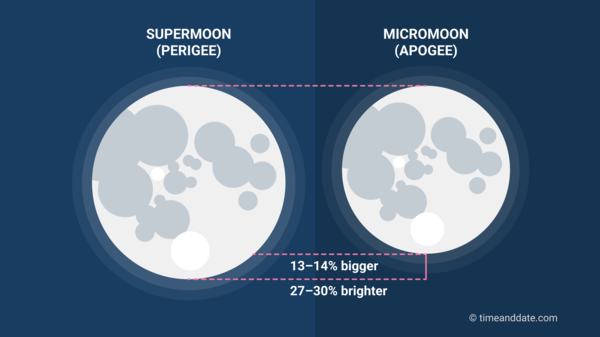The Super Harvest Moon Eclipse 2024
Five reasons why the Full Moon on the night of September 17–18, 2024, will be extra special.

September’s Full Moon will be a Harvest Moon and a Supermoon. Skywatchers in some parts of the globe will also see it partially eclipsed by Earth’s shadow.
©iStockphoto.com/Jessica-Chortkoff
1. It’s a Full Moon
The Sun, Earth, and Moon align to put on a great show on the night of September 17 to 18. Several celestial events coincide to give us a very special Full Moon: a Super Harvest Moon Eclipse.
First things first: it will be a Full Moon. This is defined as the moment when the Sun and the Moon are 180 degrees apart on opposite sides of Earth, and the visible side of the Moon’s disk is fully lit up.
This month’s Full Moon will happen on September 18, 2024 at02:34 UTC.
Full Moons rise around sunset and set around sunrise. If you miss the exact moment, it still appears full in the days before and after the main event.
Check the moonrise and moonset times for your location, and keep an eye on the latest weather reports.
2. It’s the Harvest Moon
The Harvest Moon is defined as the Full Moon closest to the autumnal (fall) equinox in the Northern Hemisphere, which this year is September 22 at 12:43 UTC.
There are both historical and astronomical reasons why exactly this Moon is named the Harvest Moon:
“Every day, on average, the Moon rises about 50 minutes later than it did the day before,” says Graham Jones, astrophysicist at timeanddate.com.
“However, in the Northern Hemisphere, for Full or nearly Full Moons close to the September equinox, the difference in the time of moonrise from one day to the next is less than 50 minutes.”
Since Full Moons rise around sunset, this results in extra moonlight in the evenings. In the past, this gave farmers more time for harvesting crops.
“In the Southern Hemisphere, it’s the opposite situation around the time of the September equinox,” adds Graham. “At Full Moon—or close to Full Moon—the difference in moonrise time on successive days is more than 50 minutes.”
Chuseok: The Harvest Moon holiday

A Super Full Moon is near its closest point to Earth in its orbit and can look bigger and brighter than a Micromoon which is near its farthest point from Earth.
3. It’s a Supermoon
The Moon’s orbit around Earth is oval or elliptical, with one side closer to Earth than the other. As a result, the distance between the Moon and Earth varies throughout the month and the year.
This year, the Harvest Moon is near its closest approach to Earth—known as perigee—making it a Supermoon.
The point on the Moon’s orbit farthest away from Earth is known as apogee.
The word Supermoon is relatively new, and different sources have different definitions. At timeanddate, we define a Supermoon as a Full or New Moon that occurs when the center of the Moon is less than 360,000 kilometers (about 224,000 miles) from the center of Earth.
The opposite of a Supermoon is a Micromoon, and on October 2, a Micro New Moon will pass the Sun for an annular solar eclipse.

timeanddate.com will be livestreaming the partial lunar eclipse on September 17–18, 2024. Image from last year’s lunar eclipse live stream.
©timeanddate.com
4. It’s a Partial Eclipse
The Earth’s lighter outer shadow, the penumbra, and a small part of Earth’s darker inner shadow, the umbra, will darken the Moon’s surface in a partial lunar eclipse. Anyone on the night side of Earth can see the eclipse, but the timings depend on which time zone you live in.
For instance, if you’re in Europe, it is deep in the night—in London, the eclipse starts at 01:41 (1:41 am) on Wednesday morning. But if you’re in North America, it happens on Tuesday evening—for example, at 20:41 (8:41 pm) in New York.
This will not be a big eclipse! At most, only about four percent—a tiny fraction—of the Moon’s disk will be covered by the darkest part of Earth’s shadow. But the effect will be striking, as one part of the Moon’s edge becomes shrouded in blackness.
Eclipse times in your location
We’re partnering up with old and new friends and sending the mobile observatory out to find clear skies to bring you live telescope images of the eclipse. Our team will guide you through the eclipse with explanations and commentary.
See the partial lunar eclipse LIVE!


Screengrab from our Night Sky Map for London, UK, at around 03:44 (3:44 am) local time on September 18, 2024—the time of maximum eclipse. For observers in this part of the world, the eclipsed Moon will share the night sky with (from the left) Mars, Jupiter, and Saturn.
©timeanddate.com
5. Look Up for Saturn, Jupiter, and Mars
But wait, there’s more: Mars, Jupiter, and Saturn are currently all on display in the night sky.
On the evening of September 17–18, Saturn will be the first of three planets to rise, around the same time as the Moon. Jupiter and Mars will rise later during the night and follow Saturn and the Moon across the sky from east to west.